Always consult your veterinarian before starting any new exercise routine for your pet. This article is for informational purposes only and does not replace professional veterinary advice.
Keeping your dog happy and healthy indoors can feel challenging—especially if you live in a condo or apartment. But you’re not alone. Many Canadian pet parents struggle to meet their dog’s activity needs without a yard. As a veterinarian in a city practice, I often help families get creative with indoor dog exercise. The good news? Even small spaces can provide big benefits with the right games and routines.
Table of Contents
Key Takeaways
- Indoor dog exercise is essential for your pet’s physical and mental health—especially in small homes without a yard.
- Games like tug, stair fetch, trick training, and puzzle feeders offer creative ways to burn energy indoors.
- Short sessions of mental stimulation can tire dogs out just as much as a walk.
- Tailor activities to your dog’s age, breed, and health. Even 5-minute games can make a big difference.
- DIY toys and obstacle courses are affordable and effective for apartment dogs.
Why Indoor Exercise Is Essential for Dogs
Every dog needs regular physical and mental activity—but if you live in a small space, indoor dog exercise becomes your main tool for preventing boredom, stress, and destructive behaviour. Dogs that don’t get enough stimulation may chew furniture, bark excessively, or develop anxiety.
Veterinary experts, including the Canadian Veterinary Medical Association (CVMA), emphasize that exercise reduces behavioral issues and strengthens the human-animal bond. Importantly, indoor dog exercise doesn’t mean compromising on quality. With a mix of movement and mind games, you can meet your dog’s needs even without daily walks.
As a city vet, I’ve treated countless dogs who seemed hyperactive or anxious—until we boosted their indoor dog exercise routine. From puzzle feeders to tug games, the results were dramatic: calmer behavior, better sleep, and improved obedience.
https://doglifeexpert.com/top-9-outdoor-dog-activities/
Physical Play in Small Spaces
Your home may be compact, but there are plenty of high-energy indoor dog exercise options that don’t require a backyard. These simple games get dogs moving safely and effectively:
Tug-of-War
A structured game of tug can elevate your dog’s heart rate and reinforce training cues like “drop it.” Use a proper tug toy, not clothing or hands. Letting your dog win occasionally boosts their confidence—especially for shy or anxious pups.
Stair Fetch (If Safe)
If your home has carpeted stairs, tossing a soft toy up or down them is a powerful cardio session. Supervise closely to avoid slips, and skip this activity for senior dogs or those with joint issues.
Indoor Fetch
Hallways make perfect fetch lanes. Use soft plush toys or rubber balls to reduce noise and prevent damage. Keep sessions short but engaging—3 to 5 tosses per round is usually enough for most dogs.
Obstacle Course
Transform furniture into a mini agility arena. Drape a blanket between chairs as a tunnel or place broomsticks across stools for hurdles. This form of indoor dog exercise builds coordination, agility, and problem-solving skills.
Flirt Pole Fun
A flirt pole (basically a dog-safe “fishing rod” with a toy) is ideal for apartment living. It encourages fast chases in a tight space without you having to run. Aim for 5- to 10-minute sessions of high-intensity bursts followed by rest.
Mixing these activities creates variety and helps avoid overuse injuries. I often recommend alternating tug with agility or flirt pole games to keep things fresh and tiring.
🔗 https://vcahospitals.com/shop/articles/fun-exercises-for-pets
Brain Games and Mental Enrichment
Mental workouts are just as important as physical ones—especially for intelligent or high-energy breeds. A well-designed indoor dog exercise plan always includes problem-solving games to keep your pup’s mind sharp.
Puzzle Toys & Food Challenges
Food-dispensing toys like the Kong, West Paw Toppl, or treat balls can turn mealtime into an engaging activity. Fill them with peanut butter, soft treats, or kibble. For a budget-friendly option, roll treats inside a towel or scatter food in a snuffle mat.
✅ West Paw Toppl Treat Toy (Chewy)
“Find It” and Hide-and-Seek

Ask your dog to stay, then hide treats or yourself. Call their name and let them sniff you out. This game exercises their recall, nose, and attention span. Gradually increase difficulty to challenge their memory and scenting skills.
Trick Training
Short trick sessions (5–15 minutes) are great for mental focus. Teach basics like “sit,” “stay,” or “down,” or add fun ones like “spin,” “wave,” or “roll over.” Using small treats and praise boosts motivation and confidence.
Nose Work Games
Hide treats under plastic cups or in different rooms. Dogs naturally love sniffing, and scent games tap into this instinct. As a vet, I’ve seen nervous dogs relax and focus during these calming, scent-driven tasks—especially when combined with soft praise.
Incorporating 1–2 brain games into your daily indoor dog exercise routine can significantly reduce hyperactivity and behavioral issues.
Activities That Combine Mind and Body
Some of the most effective indoor dog exercise routines blend physical movement with mental focus. These hybrid games are ideal for intelligent, energetic dogs that crave a challenge.
Trick Sequences
Once your dog knows a few basic commands, start combining them: “sit,” “down,” “spin,” and “jump” in a row. This sequence improves memory, body awareness, and listening skills—all while providing light cardio.
Indoor Agility Circuits
Build a mini course using household items:
- Jump: a broomstick on two piles of books
- Tunnel: a blanket over two chairs
- Weave poles: soda bottles or cushions in a zig-zag line
Guide your dog with a treat or toy through the course. This style of indoor dog exercise is especially fun for herding breeds like Border Collies or Australian Shepherds.
Red Light/Green Light or Dance Games
Teach your dog to move with you using voice cues or music. Try a modified “red light/green light” where they follow you until you stop and sit. Or dance with your pup by luring them into spins, hops, or twirls around your legs.
These games strengthen your bond while burning energy and encouraging focus. They’re a great way to blend fun with obedience in your dog’s indoor routine.
DIY Toys and Budget-Friendly Enrichment
You don’t need fancy equipment to provide great indoor dog exercise. Everyday items can become enriching tools for your dog’s play and learning time.
Toilet Roll Treat Dispensers
Stuff an empty paper towel or toilet roll with treats, fold the ends, and give it to your dog. Supervise closely to prevent cardboard ingestion. Freeze it with peanut butter for a longer challenge.
Muffin Tin Puzzle
Place treats in the cups of a muffin tray, then cover each with a tennis ball. Your dog must sniff and remove the balls to uncover the snacks. It’s a simple way to build problem-solving skills.
DIY Snuffle Mats & Towel Games
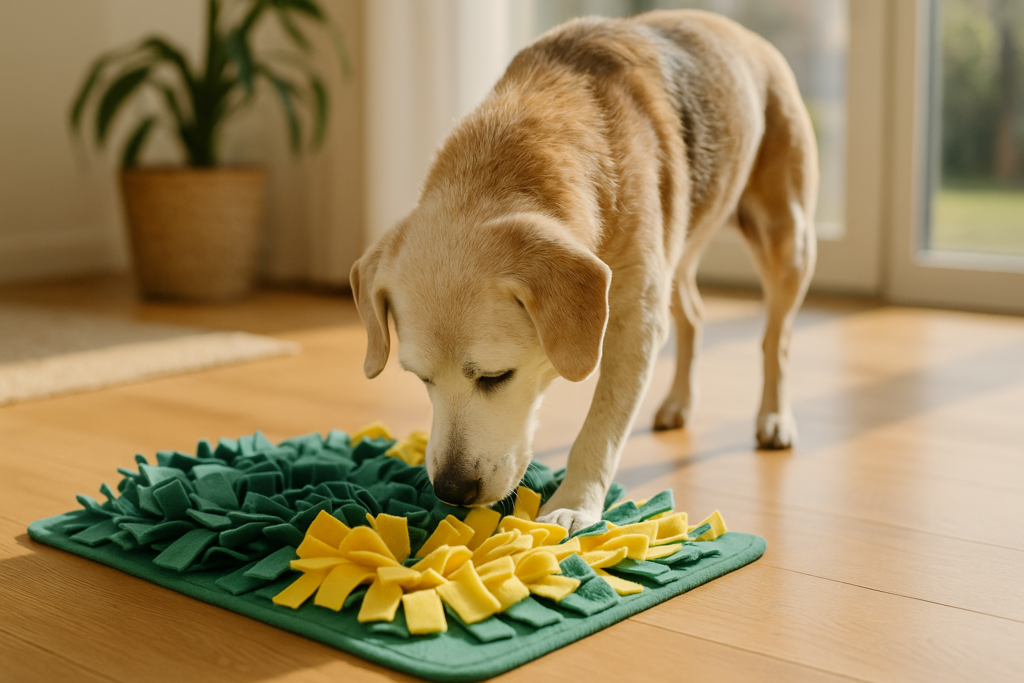
Tuck treats into a rolled-up towel or tie strips of fabric into a snuffle mat. Let your dog forage and paw through it. These scent-based games satisfy your dog’s natural instincts and offer calming stimulation.
Homemade Obstacle Courses
Turn your furniture into fun: a broomstick becomes a jump bar, a cardboard box becomes a tunnel. This kind of indoor dog exercise encourages exploration, balance, and confidence-building—especially helpful for shy or young dogs.
DIY Flirt Pole
Tie a rope toy to a broom handle or sturdy stick. Drag it across the floor, weave it through furniture, and let your dog give chase. It’s easy to make and highly effective for high-energy breeds.
These homemade enrichment ideas are not just cost-effective—they’re also fun and customizable. As a vet, I often recommend them to families with busy schedules or tight budgets who want more out of indoor dog exercise time.
Tailoring Activities by Dog Age & Breed
Not all dogs have the same play style or endurance. The best indoor dog exercise routines are personalized based on your pet’s age, breed, and health status.
Puppies
Young dogs have energy bursts followed by deep naps. Keep play sessions short (5–10 minutes), using gentle games like fetch with plush toys or nose work. Avoid stair games or jumping to protect growing joints.
Adult Dogs
Most adult dogs need 30 minutes to 2 hours of activity daily, depending on their breed. High-energy working breeds—like Huskies, Border Collies, and Retrievers—often benefit from high-intensity games like flirt pole sessions or trick sequences as part of their indoor dog exercise.
Senior Dogs
Older pups might prefer calm, low-impact games. Scent work, snuffle mats, or light training games offer both stimulation and movement without stressing joints. Monitor for signs of fatigue like panting, limping, or reluctance to play.
Breed Differences
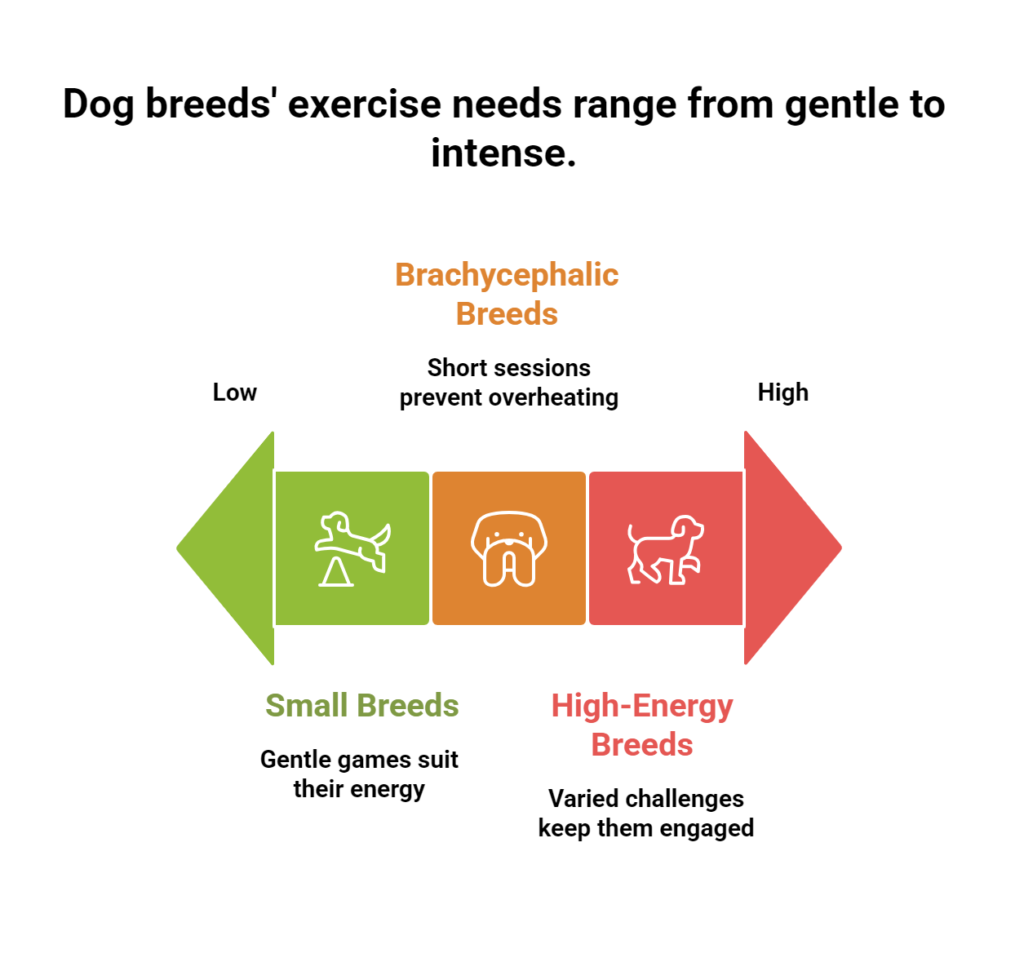
Always tailor indoor dog exercise to your dog’s individual temperament and abilities. Consult your veterinarian if you’re unsure about appropriate activities for your pet’s age or medical condition.
Safety Tips for Indoor Dog Play
Keeping indoor dog exercise both fun and safe is essential—especially in small spaces. A few smart precautions will prevent accidents and ensure a positive experience.
Choose the Right Toys
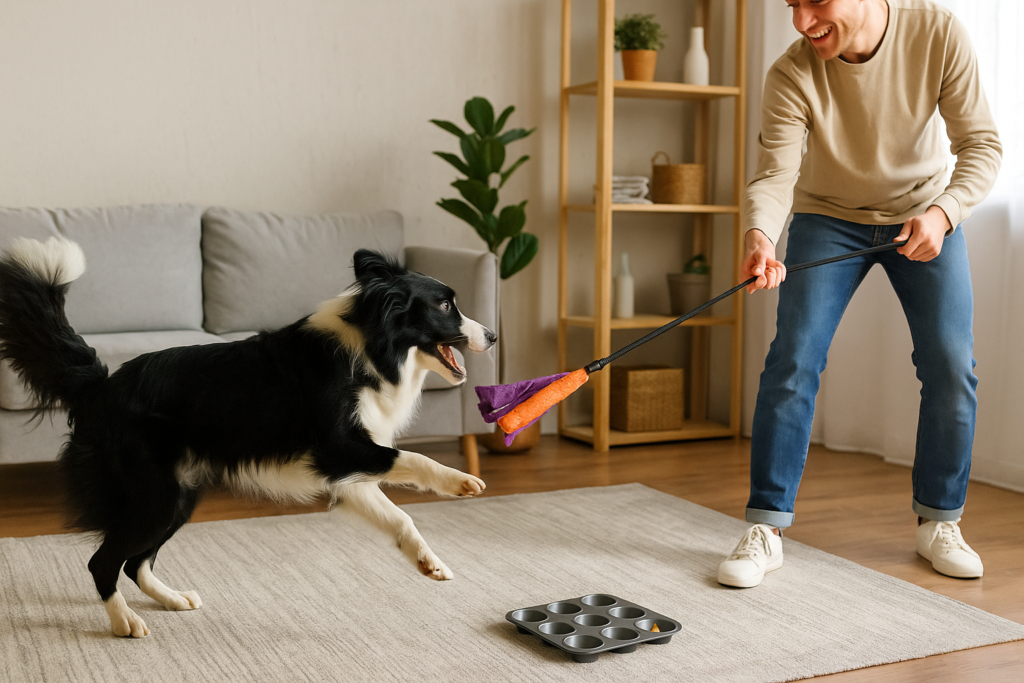
Opt for soft, durable toys made for indoor use. Avoid hard rubber balls or sharp-edged toys that can damage walls or furniture—or worse, hurt your dog’s teeth. For tug-of-war, use toys with built-in handles and never encourage biting hands or clothes.
Clear the Play Area
Before active games like fetch or flirt pole, move breakables and ensure rugs are non-slip. Create a designated “play zone” with good lighting and space to move safely.
Supervise DIY Games
Always watch your dog during games involving cardboard, fabric, or small parts. Remove chewed-up bits promptly to prevent choking. The AKC warns against leaving dogs alone with paper-based treat toys or homemade puzzles.
Moderate Intensity
Even indoor sessions can be overdone. Look for signs of overheating: heavy panting, drooling, or stopping suddenly. Play in short bursts with breaks between. This is especially important for brachycephalic or senior dogs.
Use Positive Reinforcement
Praise and treat your dog often during exercise. Keep training cues consistent and end sessions on a high note. A happy tone builds confidence and strengthens your bond.
Smart planning and gentle monitoring help indoor dog exercise stay enjoyable and injury-free. It’s not about exhausting your dog—just giving them the stimulation they crave in a safe, structured way.
5-Minute Daily Checklist for Apartment Dogs
Even if your day is packed, you can still give your dog a complete indoor dog exercise routine in short sessions. Here’s a quick checklist to mix brain and body activities every day:
✅ 2–3 minutes of tug or fetch in a hallway
✅ 2 minutes of “Find It” or scent game using treats
✅ 2–3 trick commands or review (e.g., sit, spin, stay)
✅ 2–5 minutes of flirt pole or obstacle course play
✅ 1–2 puzzle toys or a frozen treat Kong for downtime
Rotate these based on your dog’s mood and energy. Even 10–15 minutes of quality indoor activity spread throughout the day can make a huge difference in behavior and health.
As a vet, I’ve seen countless urban dog families thrive with micro-sessions of indoor dog exercise—no yard needed!
Typical Canadian Costs of Indoor Dog Enrichment
You don’t need to spend a fortune to create a stimulating indoor dog exercise routine. Here’s a breakdown of average prices for popular enrichment tools in Canada:
| Item | Approx. Cost (CAD) | Notes |
|---|---|---|
| Kong Classic Toy | $15–25 | Durable and versatile for food puzzles |
| West Paw Toppl Treat Toy | $25–35 | Great for soft foods and frozen treats |
| Snuffle Mat | $20–40 | Encourages scent work and slow feeding |
| Flirt Pole (store-bought) | $25–45 | Engaging for high-energy dogs |
| DIY Flirt Pole (homemade) | ~$5 (materials only) | Use rope and an old broomstick |
| Puzzle Toys | $15–50 | Various difficulty levels available |
| Muffin Tin Puzzle (DIY) | Free (household item) | Just add tennis balls and kibble |
Many pet parents combine store-bought items with homemade solutions for a balanced approach to indoor dog exercise that fits any budget.
Prevention Tips for Indoor Boredom
Consistency and variety are key to keeping indoor dog exercise fresh and effective. Here’s how to prevent your dog from getting bored indoors:
Rotate Toys Weekly
Keep just 2–3 toys out at a time. Store the rest and rotate weekly to reignite interest in “old” toys that feel new again.
Set a Play Schedule
Dogs thrive on routine. Schedule short play sessions throughout the day (morning, lunch, evening) to spread out energy use.
Create Environmental Enrichment
Add a perch near a window for visual stimulation, use calming background music, or provide a cardboard box for sniffing and pawing.
Teach New Tricks
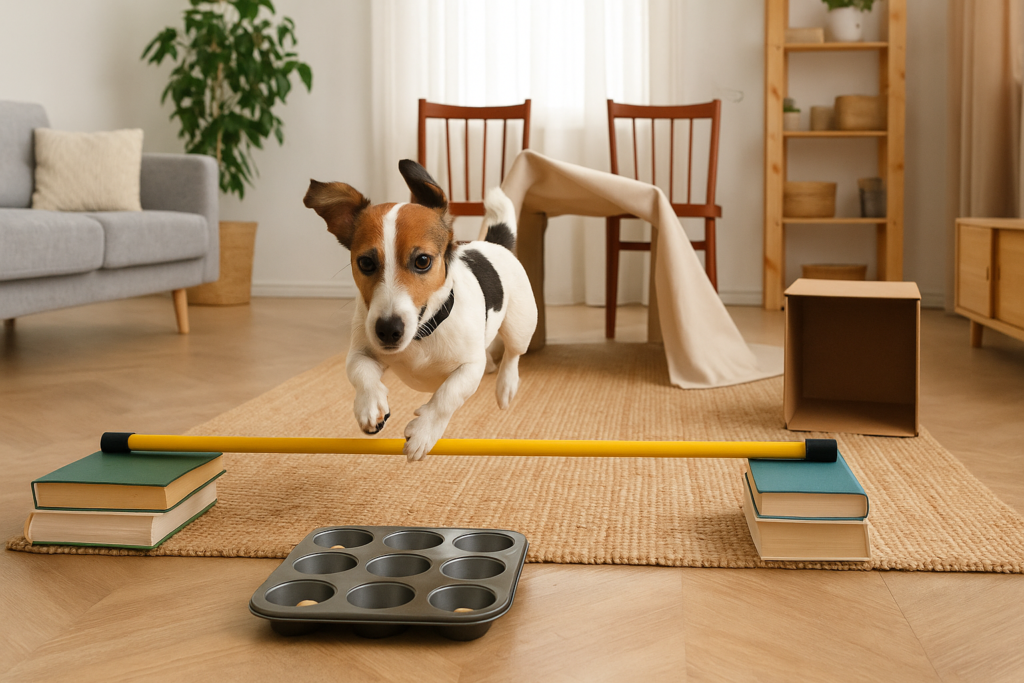
Mental stimulation reduces boredom-driven behaviors. Even learning “roll over” or “tidy up” their toys can give a strong sense of accomplishment.
Use Food as a Game
Ditch the bowl! Feed part or all of your dog’s meals through treat balls, puzzle toys, snuffle mats, or slow-feeders.
Veterinary behaviorists emphasize that enriching your dog’s home environment reduces stress and encourages calm, well-mannered behavior. By treating indoor dog exercise as an evolving, interactive experience, you’ll help your pup thrive inside your home.
FAQ – Indoor Dog Exercise
1. Can my dog be healthy without outdoor walks?
Yes, with a well-planned indoor dog exercise routine that includes physical play and mental stimulation, your dog can stay healthy and content. However, walks offer unique sniffing and socializing opportunities, so aim for occasional outdoor time if possible.
2. What are signs my dog isn’t getting enough exercise?
Common signs include destructive chewing, hyperactivity, barking, pacing, or attention-seeking behavior. Increasing indoor dog exercise sessions usually improves these behaviors quickly.
3. How often should I play with my dog indoors?
Aim for two or three short play sessions daily, totaling 30–60 minutes depending on your dog’s energy. Combine physical games with brain work to get the most from each session.
4. What if I don’t have stairs or a hallway?
No problem! Use tug games, flirt poles, nose work, and trick training. Small spaces can still offer rich, engaging indoor dog exercise with the right setup.
5. How do I calm a high-energy dog indoors?
Start with 5–10 minutes of physical play (flirt pole, fetch), followed by brain games (puzzles, trick sequences). Finish with a calming activity like scent work or chewing a stuffed Kong.
6. Is it OK to reuse the same games every day?
Yes—but rotate how you use them. Switch up hiding spots for scent games, change puzzle contents, or modify obstacle courses to keep indoor dog exercise interesting and engaging.
Conclusion
Living in a small space doesn’t mean your dog has to miss out on fitness or fun. With a bit of creativity, indoor dog exercise can fully meet your pup’s mental and physical needs. Whether it’s a game of tug, a DIY snuffle mat, or a five-minute trick session, every little activity adds up to a happier, calmer, and healthier dog.
As a veterinarian, I’ve seen firsthand how a consistent, thoughtful indoor dog exercise routine can transform a dog’s behavior—and their bond with their human. No yard? No problem. Your living room, hallway, or even your kitchen can become your dog’s new favorite playground.
Keep exploring, rotating, and bonding. Your dog will thank you with tail wags, quieter nights, and loving looks.

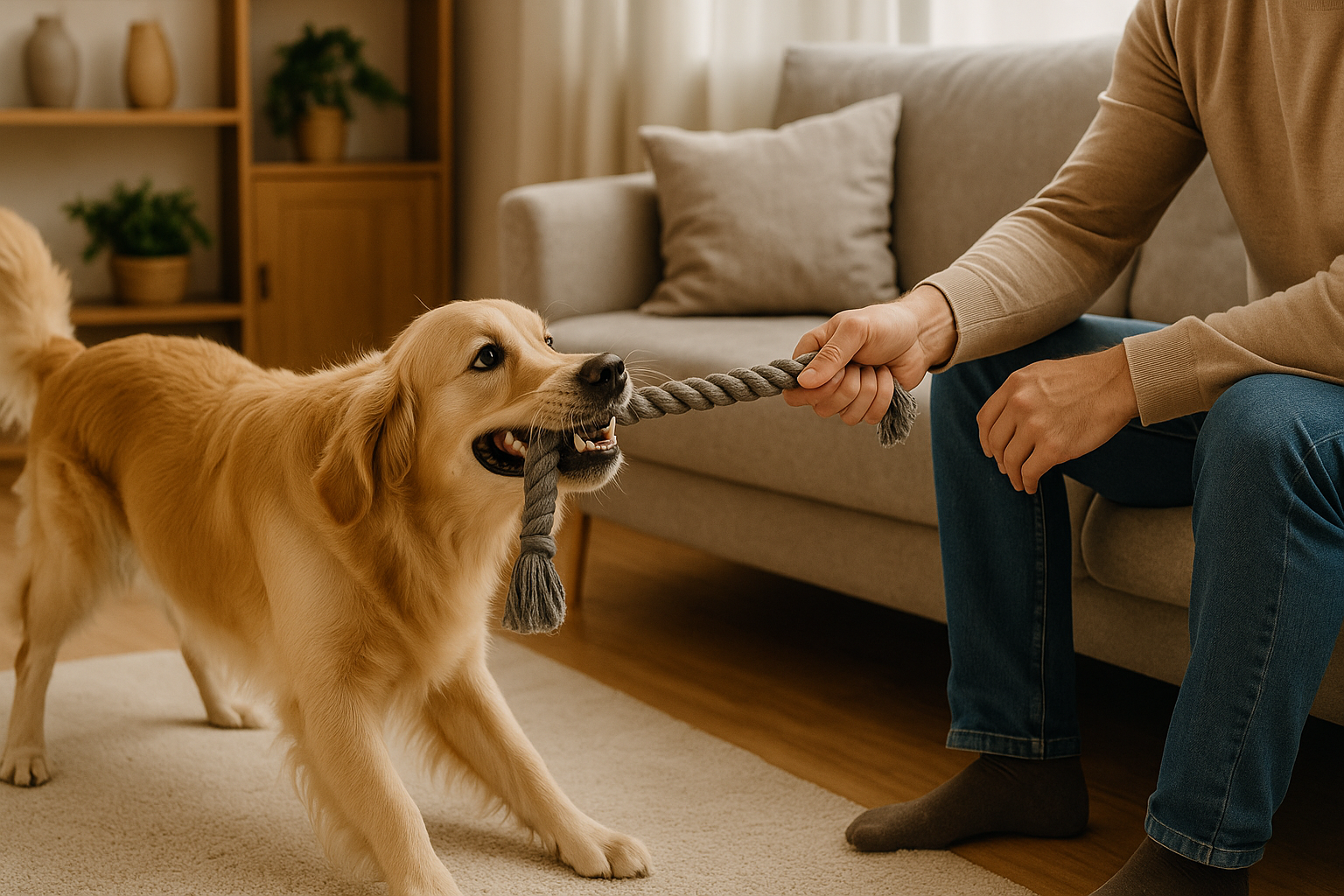
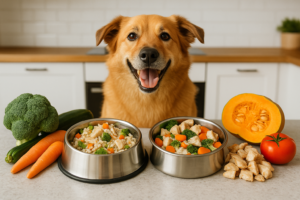
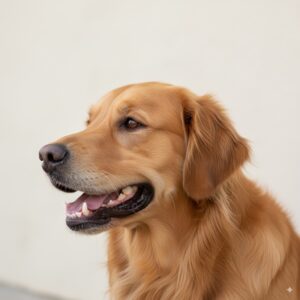
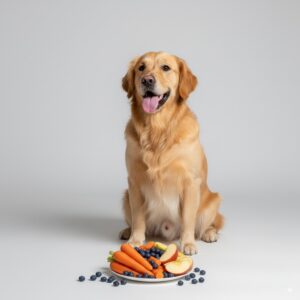
Pingback: Early Signs of Arthritis in Dogs & Home Care Tips 2025
Pingback: Spotting Early Arthritis in Dogs: Signs and How to Help: vet advice 2025